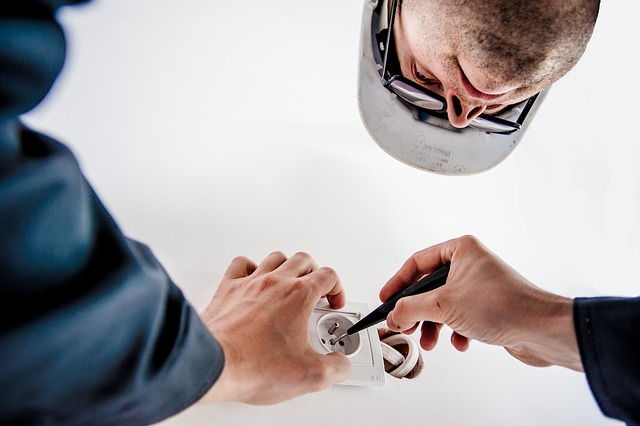Electricians play a pivotal role in modernizing energy systems by upgrading legacy infrastructure with smart thermostats, LED lighting, and high-efficiency HVAC units. They conduct thorough assessments to identify areas for improvement in existing electrical setups, focusing on enhancing both performance and energy efficiency while ensuring compliance with safety standards. Their expertise is essential for retrofitting older buildings with modern solutions that address outdated wiring, inefficient systems, and potential fire hazards. By doing so, they help building owners save on costs and conserve the environment. Additionally, homeowners looking to improve their property's energy efficiency should consider smart meters or energy monitors for monitoring consumption and conduct a comprehensive review of major energy-consuming appliances. An experienced electrician can perform a home energy audit to pinpoint energy loss and suggest upgrades tailored to the home's needs and the family's lifestyle. It is imperative to hire a licensed electrician for any installation or upgrade work to ensure technical and code compliance. This approach not only makes buildings more responsive to current and future energy demands but also positions them for sustained efficiency and adaptability.
As we navigate the challenges of climate change and rising energy costs, upgrading old systems to modern, energy-efficient standards has become a pivotal step in sustainable living. This article delves into the transformative role of electricians in this transition, providing homeowners with a clear path to enhanced efficiency. We will explore the latest technologies, regulations, and cost-benefit considerations for retrofitting versus replacing systems. From the impact of smart thermostats to the benefits of LED lighting, each aspect of energy conservation is examined. Electricians are not just service providers; they are catalysts for sustainable living practices, adept at integrating renewable energy solutions with existing wiring infrastructures and ensuring professional safety checks. Homeowners will find valuable guidance on assessing their current system’s efficiency and learn about available tax incentives and rebates that encourage the adoption of energy-efficient upgrades. By highlighting successful case studies and outlining the necessary training for electricians, this article aims to empower readers with the knowledge to make informed decisions in their journey towards an energy-efficient future.
- Embracing Modernity: The Role of Electricians in Upgrading Old Systems
- Assessing Current System Efficiency: A Step-by-Step Guide for Homeowners
Embracing Modernity: The Role of Electricians in Upgrading Old Systems

As our infrastructure ages, the necessity to embrace modernity in energy efficiency becomes paramount. Electricians play a pivotal role in this transformation by upgrading old systems to meet contemporary energy-efficient standards. These skilled professionals are at the forefront of integrating cutting-edge technologies such as smart thermostats, LED lighting solutions, and high-efficiency HVAC systems into legacy structures. Their expertise ensures that these advancements not only reduce energy consumption but also enhance overall system performance and longevity. The process involves a meticulous assessment of existing electrical installations to identify areas for improvement and the implementation of upgrades that align with sustainability goals. Electricians are adept at navigating the complexities of retrofitting older buildings, which often have outdated wiring and inefficient systems that can pose fire risks or lead to significant energy waste. By adhering to the latest codes and standards, electricians facilitate a seamless transition to modern energy-efficient systems, thereby contributing to environmental conservation and cost savings for property owners. This critical work not only extends the life of aging infrastructure but also positions buildings to be more responsive to occupant needs and adaptable to future energy innovations.
Assessing Current System Efficiency: A Step-by-Step Guide for Homeowners

When considering an upgrade to modern energy-efficient standards, a thorough assessment of your current system’s efficiency is paramount. Homeowners can begin this process by conducting an initial survey of their home’s energy usage. This involves monitoring electricity consumption through smart meters or energy monitors, which provide real-time data on power usage. The next step is to identify all major appliances and systems that contribute to your home’s energy footprint, such as heating, ventilation, and air conditioning (HVAC) units, water heaters, and lighting fixtures. An experienced electrician can play a crucial role here by inspecting these components for signs of wear, outdated technology, or inefficiencies that may benefit from an upgrade. They can also recommend energy assessments, which typically include a home energy audit. This audit will pinpoint areas where your home is losing energy and highlight opportunities for improvement. Additionally, the electrician can advise on the specifications of new, energy-efficient systems that align with your home’s layout and your family’s needs. By understanding your current system’s efficiency and potential upgrades, you can make informed decisions to enhance your home’s energy performance and reduce your carbon footprint. Always ensure that any proposed work is carried out by a licensed electrician who understands both the technical aspects of modern systems and local building codes.
In conclusion, the transition from outdated systems to modern energy-efficient standards is not merely an upgrade; it’s a leap towards a sustainable future. Electricians play a pivotal role in this evolution, expertly navigating the needs of homeowners to assess and enhance system efficiency. By following the comprehensive guide outlined in this article, homeowners can make informed decisions that contribute to energy savings and environmental responsibility. Embracing modernity through these upgrades is an investment in comfort, cost-effectiveness, and a healthier planet. Homeowners are encouraged to engage with skilled electricians who specialize in energy-efficient solutions to ensure their homes keep pace with advancements in technology and sustainability.
